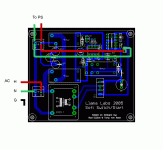I'll take a look at adding an LED to indicate that the soft switch is in the ON state.
Yes, the idea behind making them single sided (and providing the .brd file) was to allow people to etch their own if they are so inclined.
As for a BOM...perhaps I can slap one together tomorrow.
Yes, the idea behind making them single sided (and providing the .brd file) was to allow people to etch their own if they are so inclined.
As for a BOM...perhaps I can slap one together tomorrow.
ble0t said:I'll take a look at adding an LED to indicate that the soft switch is in the ON state.
Yes, the idea behind making them single sided (and providing the .brd file) was to allow people to etch their own if they are so inclined.
As for a BOM...perhaps I can slap one together tomorrow.
Yes, the idea behind making them single sided (and providing the .brd file) was to allow people to etch their own if they are so inclined.
As for a BOM...perhaps I can slap one together tomorrow. [/B][/QUOTE]
ble0t, could you provide the ".sch" that links to your ".brd" as well, this is becoming a good learning tool for me.
Thank you for your work and sharing.
Stan
That looks great! I might redraw the board to use one of the less expensive transformers ($3), as I think a torroid for this application is a little overkill (no affect on the audio). I'll post my changes if I can ever get around to making them.
Thanks!!
Thanks!!
1.5 VA would be sufficient so yes, overkill was the word and overkill in the wrong place.BrianDonegan said:... I think a torroid for this application is a little overkill (no affect on the audio)
I just used the 5VA Amveco toroid because I had already designed the part in my library and I happen to have an extra I was going to use for this 😉
I'm sure there are a couple smaller ones (especially one I can source from Mouser to keep the order from one place)...perhaps I'll change the board tonight.
I'm sure there are a couple smaller ones (especially one I can source from Mouser to keep the order from one place)...perhaps I'll change the board tonight.
OK...I was on lunch and couldn't resist playing with Eagle again 😀
Here's an updated board using this smaller transformer from Mouser. It's the 115V primary type, but they have 230V that are identical for anyone outside the US. The board is about half an inch smaller as well.
Here's an updated board using this smaller transformer from Mouser. It's the 115V primary type, but they have 230V that are identical for anyone outside the US. The board is about half an inch smaller as well.
Attachments
No...the smaller header is for the connection to the momentary switch, which should be SPST. Take a peak back at post #7 in this thread...perhaps then it will seem a bit clearer 😎
Member
Joined 2002
No, although I've built both circuits seperately and they have worked without any problems. It should work fine, but if someone would like to test it out, that'd be great 😉
ble0t said:No...the smaller header is for the connection to the momentary switch, which should be SPST. Take a peak back at post #7 in this thread...perhaps then it will seem a bit clearer 😎
O.K., I get it now, when I saw the schematic switch in post 7 I did not know it was a (momentary switch) just a regular sp/st. thanks, makes sense now!
Just posted something similar in another thread, but this may be useful...
I was reading about these:
http://rocky.digikey.com/WebLib/Qua...H (QProx).pdf
Basicically creates a touch sensitive switch using jsut about anything as the switch surface. If you ground the two option pins, it operates in toggle mode (ala on/off switch). If you have the output feed a transitor and then a relay...
Only $1.98US each at digikey, and all it requires is a tiny capacitor.
I'm probably gonna use them behind a glass front panel for power, volume and balance on a preamp.
I was reading about these:
http://rocky.digikey.com/WebLib/Qua...H (QProx).pdf
Basicically creates a touch sensitive switch using jsut about anything as the switch surface. If you ground the two option pins, it operates in toggle mode (ala on/off switch). If you have the output feed a transitor and then a relay...
Only $1.98US each at digikey, and all it requires is a tiny capacitor.
I'm probably gonna use them behind a glass front panel for power, volume and balance on a preamp.
BrianDonegan said:Just posted something similar in another thread, but this may be useful...
I was reading about these:
http://rocky.digikey.com/WebLib/Qua...H (QProx).pdf
Basicically creates a touch sensitive switch using jsut about anything as the switch surface. If you ground the two option pins, it operates in toggle mode (ala on/off switch). If you have the output feed a transitor and then a relay...
Only $1.98US each at digikey, and all it requires is a tiny capacitor.
I'm probably gonna use them behind a glass front panel for power, volume and balance on a preamp.
Hi Brian, could you post the part #, for some reason I can't connect to your link, thanks!
Still could not link, (prob on my side) found it though -
http://www.qprox.com/products/qtouch.php
very cool...
http://www.qprox.com/products/qtouch.php
very cool...
That would be a really neet thing to use in conjunction with some smoke acrylic and some backlighting 😉
ble0t said:That would be a really neet thing to use in conjunction with some smoke acrylic and some backlighting 😉
Yes, I was thinking of silkscreening the symbol on the back of 1/4"
plate glass and then applying a flat field of color (any color you want) behind the symbol, leaded enamel works, flip the panel over to the front, great.
Attachments
- Status
- Not open for further replies.
- Home
- Amplifiers
- Solid State
- Soft start & Soft Switch circuit: can anybody help?

